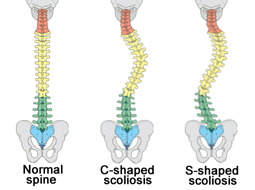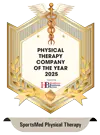What is Scoliosis?
Scoliosis is a condition where there is an abnormal bend in the spine. There are two types of bends that occur naturally – kyphosis and lordosis. Kyphosis is the forward bend that occurs in the upper back or thoracic spine and lordosis is the backwards bend that occurs in the lower back or cervical spine. Scoliosis is when the spine bends laterally and forms a ‘C’ or ‘S’ Shape.
Symptoms of Scoliosis
The degree of the abnormal curve will affect the severity of symptoms. Common visible symptoms include:
- Head not centered over the pelvis
- One shoulder higher than the other
- Misaligned rib cages
- Waist not level
- One hip higher than the other
- Body leans to one side
- Body Musculature is uneven
- One leg longer than the other
Mild scoliosis may cause little to no symptoms. In more severe instances, problems with back pain or fatigue can be felt after sitting or standing for too long. The condition can get worse over time and lead to other more serious issues, such as altered organ function. In this case, the curve causes abnormal rib cage alignment can place pressure on organs if scoliosis is left untreated.
Do You Have Scoliosis? Schedule an Appointment Today!
If you have any questions, or want a consultation with a professional, feel free to call, or schedule an appointment online at any of our Bergen County or Passaic County offices in New Jersey. Choose from Glen Rock, Franklin Lakes, Fair Lawn, Ho-ho-kus/Ridgewood, and/or Clifton – we make it possible for you to visit any of our offices at your convenience.
Causes of Scoliosis
Scoliosis occurs more frequently in females ages 10-12 and early teens. Most of the time there is no known cause and other times formation of scoliosis can be linked to:
- Neuromuscular conditions such as cerebral palsy or muscular dystrophy/atrophy
- Birth defects that affect spinal bone growth such as spina bifida
- Spinal Injures
- Tumors
- Non matching leg length
- Marfan Syndrome (disease of connective tissue)
- Arthritis in the spine
- Bone Spurs
- Osteoporosis
It can occur later in life, even though not symptoms were seen in youth. The presence of tumors or osteoporosis in the spine can cause a person to lean more to one side in order to reduce pain. This altered position can compromise spinal alignment.
Treatment for Scoliosis
Scoliosis is treated based on how sever it is and how likely it is to get worse. If the condition is functional, that means that the spine is fine but it is affected by an issue somewhere else in the body. In this case, the issues are treated and the spine is left alone. If scoliosis is caused by a neuromuscular condition, it is possible surgery is required to prevent any further compromise.
Braces are sometimes used in infants, juveniles, or adolescents who are still growing to help ensure proper alignment. Of the three, juveniles have the most issues because this is the greatest period of growth. After an individual stops growing, bracing is no longer effective and surgery may be required if the curve is too great.
If surgery is required, the goal is to correct the spine as much as possible and then perform a spinal fusion to hold it in place.
Prevention of Scoliosis
The best way to prevent scoliosis is to detect it as early as possible. If it runs in the family, be sure to get your child checked with regular physicals. There are many school programs that now do this, which greatly helps to determine issues early on. Because the cause of most cases is undetermined, it is not easy to prevent. The best you can do is instill habits of keeping good posture and avoid carrying too much weight on just one side of the body.



